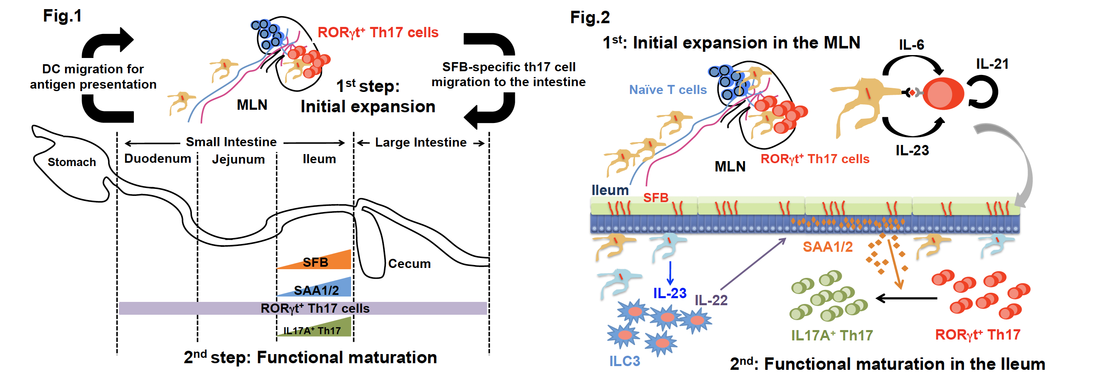For lay audiences and students, click next button!
Our research
My post-doctoral work has been focused on understanding the in vivo mechanisms of commensal-induced Th17 cell differentiation during homeostasis. Th17 cells, which are induced by the commensal Segmented Filamentous Bacteria (SFB) in the mouse gut, have important functions in host defense from pathogens but are also associated with autoimmune diseases such as inflammatory bowel disease (IBD) and Rheumatoid Arthritis (RA). We described a two-step process for the functional differentiation of intestinal Th17 cells following SFB colonization during homeostasis in Cell (2015). Following SFB gavage, antigen-specific CD4+ T cells were primed and polarized to express RORgt, but these Th17 cells do not produce effector cytokines such as IL-17A in the intestine-draining Mesenteric lymph nodes (MLN). Following the migration of recently induced RORgt+ Th17 cells to the intestinal lamina propria, Th17 cells modestly upregulated effector cytokines. However, robust IL-17A producing Th17 cells were enriched in the ileum, where SFB makes direct contact with the epithelium1 (Fig.1). We have demonstrated an SFB-triggered circuit in which Type 3 Innate lymphoid cell (ILC3) secretion of IL-22 was critical for the local epithelial production of serum amyloid A (SAA) 1/2, which acted directly on Th17 cells for the robust maturation of their effector program1 (Fig.2). These findings suggested that local factors in the tissue microenvironment could contribute to the balance of homeostatic Th17 cells important for host protection and pathogenic Th17 cells implicated in autoimmunity.
In the GF mice, not only Th17 cells but also other types of immune cells are also inactive or less compared with SFP/conventional mice. Thus, GF mice are very weak against pathogen infection and tissue damages. More interestingly, GF mice will show no or much weaker inflammation when we apply several disease condition such as IBD, RA, and MS, suggesting that commensal bacteria can contribute on both protective and pathogenic immune responses. But which and how our commensals can affect these two-edges phenotype are largely unknown.
Project 1: To isolate immunogenic bacteria which induce immune cell differentiation, activation, and suppression
Project 2: To classify the immunogenic bacteria into several categories: Protective, Pathogenic, or....
Project 3: To elucidate the cellular and molecular mechanisms by which these bacteria alter immune responses
Project 2: To classify the immunogenic bacteria into several categories: Protective, Pathogenic, or....
Project 3: To elucidate the cellular and molecular mechanisms by which these bacteria alter immune responses
